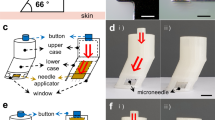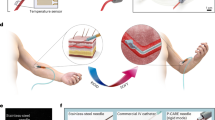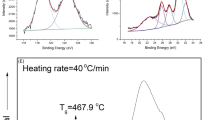Abstract
Drug delivery by lateral tail-vein injection in mice is widely used in preclinical research, but the technique is laborious to perform because the tail vein is hardly visible and too small to be cannulated. Misinjections of test components can lead to defective or even false experiment results. We present a simple but useful injection-assistant device to visualize the tail vein of mice. The device consists of a light-emitting diode (LED) circuit and a finger component. The finger component consists of an open-looped ring to slide on the finger, a slot to accommodate the mouse’s tail and a lamp cage in which to set the LED lamp. Once the mouse’s tail has been illuminated, the tail vein can be clearly seen as a dark line along the bright background of the tail, which facilitates venipuncture and improves the success rate of tail-vein injection. If the protocol provided has been followed correctly, a robust tail-vein injection-assistant device can be set up in 3 h with low-cost components.
This is a preview of subscription content, access via your institution
Access options
Subscribe to this journal
We are sorry, but there is no personal subscription option available for your country.
Buy this article
- Purchase on Springer Link
- Instant access to full article PDF
Prices may be subject to local taxes which are calculated during checkout



Similar content being viewed by others
Data availability
The stereolithography files for fabricating the custom parts are provided in Supplementary Data. The videos about assembling and operating this device are provided as Supplementary Videos accompanying this protocol. Source data are provided with this paper.
References
Steel, C. D., Stephens, A. L., Hahto, S. M., Singletary, S. J. & Ciavarra, R. P. Comparison of the lateral tail vein and the retro-orbital venous sinus as routes of intravenous drug delivery in a transgenic mouse model. Lab Anim. (NY) 37, 26–32 (2008).
Vines, D. C., Green, D. E., Kudo, G. & Keller, H. Evaluation of mouse tail-vein injections both qualitatively and quantitatively on small-animal PET tail scans. J. Nucl. Med. Technol. 39, 264–270 (2011).
Groman, E. V. & Reinhardt, C. P. Method to quantify tail vein injection technique in small animals. Contemp. Top. Lab. Anim. Sci. 43, 35–38 (2004).
Donovan, J. & Brown, P. Parenteral injections. Curr. Protoc. Immunol. 73, 1.6.1–1.6.10 (2006).
McGill Comparative Medicine and Animal Resources Center. Mouse Intravenous Injection Handout (cited 12 February 2021) Available from https://www.mcgill.ca/cmarc/workshops (2016).
The University of British Columbia. Tail Vein Injection in the Mouse and Rats (cited 12 February 2021) Available from https://animalcare.ubc.ca/animal-care-committee/sops-policies-and-guidelines/standard-operating-procedures (2014).
Huang, C. Lateral Tail Vein Angiography Apparatus for Mouse Tail Vein Injection. CNPatent CN208709863U filed 11 Mar 2018 and issued 9 Apr 2019.
Veinlite. Veinlite Research. (cited 2021 Feb 12) Available from https://www.veinlite.com/research (2021).
Wu, Q. et al. An Assistant Device for Mouse Tail Vein Injection. CNPatent CN212346805U, filed 17 March 2000 and issued 15 January 2021.
Resch, M., Neels, T., Tichy, A., Palme, R. & Rülicke, T. Impact assessment of tail-vein injection in mice using a modified anaesthesia induction chamber versus a common restrainer without anaesthesia. Lab. Anim. 53, 190–201 (2019).
Chang, Y.-C. et al. An automated mouse tail vascular access system by vision and pressure feedback. IEEE ASME Trans. Mechatron. 20, 1616–1623 (2015).
Ahmed, S. S., Li, J., Godwin, J., Gao, G. & Zhong, L. Gene transfer in the liver using recombinant adeno-associated virus. Curr. Protoc. Microbiol. 29, 14D.6.1–14D.6.32 (2013).
Yano, J., Lilly, E. A., Noverr, M. C. & Fidel, P. L. A contemporary warming/restraining device for efficient tail vein injections in a murine fungal sepsis model. J. Vis. Exp. https://doi.org/10.3791/61961 (2020).
Acknowledgements
The authors thank Wei Zhang for the initial idea of making a portable device for assisting tail-vein injection. We also thank members of the BioMed Lab for actively trying out and offering feedback and for their encouragement and support in making the tail vein–illuminating ring a handy tool. This work was supported by the National Natural Science Foundation of China (grant no. 81772318).
Author information
Authors and Affiliations
Contributions
J.Z. and Q.W. designed the study. Q.W., Z.X., S.L., N.B. and J.Z. developed the 3D model of the tail vein–illuminating ring. Q.W., S.L. and N.B. developed the 3D model of the mouse-restraining device. Q.W. and Z.X. developed the alkaline battery–charged LED circuit. S.L., B.C., X.Y. and R.T. tested the device on mice and recorded the efficiency of the device. Q.W., Z.X. and J.Z. wrote the manuscript. All of the authors read and approved the final manuscript.
Corresponding authors
Ethics declarations
Competing interests
The authors declare no competing interests.
Additional information
Peer review information Lab Animal thanks the anonymous reviewer(s) for their contribution to the peer review of this work.
Publisher’s note Springer Nature remains neutral with regard to jurisdictional claims in published maps and institutional affiliations.
Supplementary information
Supplementary Information
Supplementary Figures 1–5.
Supplementary Data
Stereolithography files for fabrication of custom-built parts required for tail vein–illuminating ring and mouse-restraining device assembly.
Supplementary Video 1
Visualization of the main steps for the assembly of the tail vein–illuminating ring.
Supplementary Video 2
Visualization of the main steps for tail-vein injection by using the tail vein–illuminating ring.
Source data
Source Data Fig. 3
Raw data of the curve in Fig. 3b and statistical data for Fig. 3c,d.
Rights and permissions
About this article
Cite this article
Wu, Q., Xing, Z., Luo, S. et al. Assembly and operation of an easy-to-make portable device for facilitating mouse lateral tail-vein injection. Lab Anim 51, 11–21 (2022). https://doi.org/10.1038/s41684-021-00889-7
Received:
Accepted:
Published:
Issue Date:
DOI: https://doi.org/10.1038/s41684-021-00889-7



